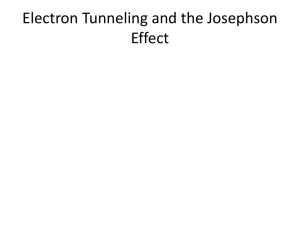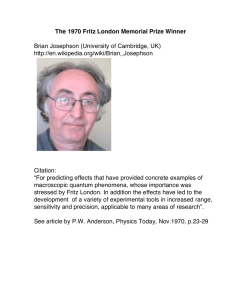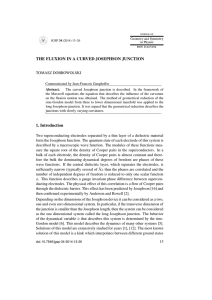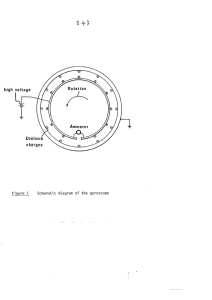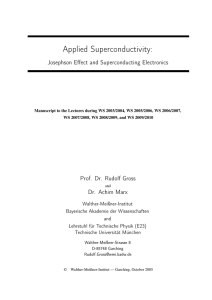SQUID - Superconducting Quantum Interference Devices
advertisement
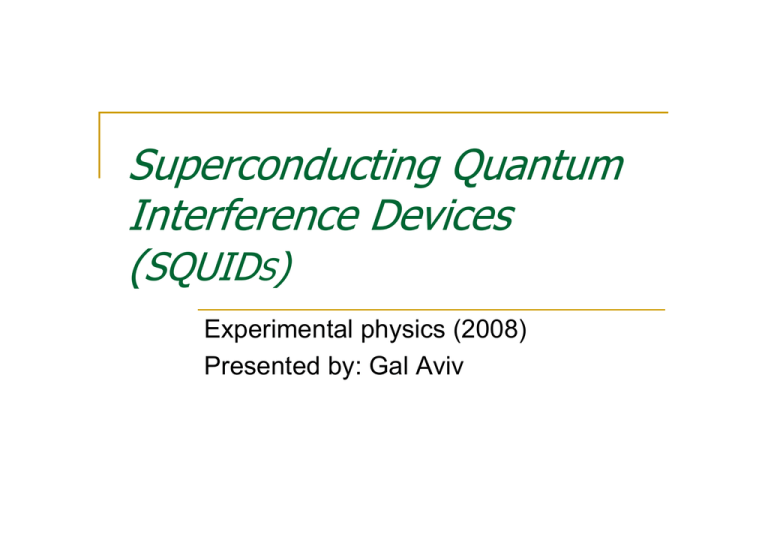
Superconducting Quantum Interference Devices (SQUIDS) Experimental physics (2008) Presented by: Gal Aviv Background Superconducting Quantum Interference Devices (SQUIDs). Detect a change in an applied magnetic flux. These changes can be used to measure any physical quantity related to flux (magnetic field, current, voltage, magnetic susceptibility, etc.). Sensitivity Los Alamo s Research Quarterly (Spring 2003) Magnetic fields Small magnetic moments induced by spin of unpaired electrons. µ Spin 1 = h 2 Magnetism occurs when spins order Courtesy of Addison-Wesley Types of metals magnetism Paramagnetism Ferromagnetism All spins are aligns in same direction. Antiferromagnetism No spin order in absence of magnetic filed All spins are aligns in opposite direction. Ferrimagnetism Spin magnitude is greater in one direction. The Meissner Effect (1933) Superconductors While doing phase transition to the superconductor state: Their resistance jumps zero. Their magnetic behavior changes. It will actively exclude any magnetic field present. The Meissner Effect (cont.) Circulating currents will be induced to oppose the buildup of magnetic field in the conductor (Lenz's law). The induced currents in it would meet no resistance. Precession occurs in whatever magnitude necessary to perfectly cancel the external field change. Flux Quantization In 1961 Deaverand and Fairbank did experiments with a tiny superconducting cylinder made by electroplating tin on a copper wire. They found magnetic flux quantizedin units of −15 Φ 0 = 2 ⋅10 Tm 2 such that the flux through the cylinder was given by Φ m = nΦ 0 Experimental Evidence for Quantized Flux in Superconducting Cylinders Phys. Rev. Lett. 7, 43 - 46 (1961) Josephson junction (1963) B. D. Josephson. The discovery of tunnelling supercurrents. Rev. Mod. Phys. 1974; 46(2): 251-254. A Josephson junction is made up of two superconductors lightly separated. Cooper pairs of electrons can experience tunneling of through the junction. Josephson current: The flow of current between the superconductors in the absence of an applied voltage. Josephson tunneling: the movement of electrons across the barrier. Josephson interferometer: Two or more junctions joined by superconducting paths. Josephson, Esaki, and Giaever shared the Nobel Prize for Physics in 1973 Josephson effect, B. D. Josephson (1962) Josephson junction, John Rowell and Philip Anderson at Bell Labs (1963). B. D. Josephson The DC and AC Josephson effect DC Josephson effect: current proportional to the phase difference of the wave functions can flow in the junction in the absence of a voltage. AC Josephson effect: electrons will oscillate with a characteristic frequency. The frequency is proportional to the voltage across the junction. great accuracy. The barrier effects only on the amplitude. Josephson Voltage Standard When a DC voltage is applied to a Josephson junction, the junction oscillation of frequency: 2e∆V f Josephson = h The relationship of voltage to frequency involves only fundamental constants Frequency can be measured with extreme accuracy. The standard volt is now defined as the voltage required to produce a frequency of 483,597.9 GHz. Voltages with accuracies of 10-10V. NIST has produced a chip with 19000 series junctions to measure voltages on the order of 10 volts with this accuracy. One-Junction SQUID (RF SQUID) (1970) Interference of the superconducting wavefunction across the Josephson junction. The interference is periodic function of the magnetic field linking the loop. The internal flux in the loop will be the sum of the external flux and the reaction flux. The SQUID is coupled to the tank circuit via mutual inductance M. I Loop 2π = − I C sin (Θ ex + LI Loop ) Θ0 2π I = I L + I C sin (Θ ex + LI Loop ) Θ0 IC is the total of the set of M junctions in a raw Θ0 = h/2e James Edwars Zimmerman and Arnold Silver at Ford Labs (1965) RF SQUID One-junction SQUID normalized inductor current. The arrows show the discontinuous transition for the βL =5 case. 2πLI C βL = Θ0 T. V. Duzer, Principles of super conductive devices and circuits (1999) Detected RF voltage as a function of applied flux for various increasing RF current levels Multi-Junction SQUIDS (dc SQUIDS) (1964) There is common electron-pair wave function through the upper superconductor and another in the lower one. Magnetic flux pass through the loop changes the relation between the phase difference across the two junctions. Robert Jaklevic, John Lambe, Arnold Silver, and James Mercereau of Ford Research Labs (1964) dc SQUIDS Based on the interference effects in the twojunction SQUID. T. V. Duzer, Principles of super conductive devices and circuits (1999) Gradiometers Measures magnetic flux gradients. For measuring a field produced by the human body. To eliminate slow changing external fields. SQUID devices Brain Imaging MEG 155 SQUID sensors. Cooled by liquid helium to 40 K. Bob Kraus SQUID team at Los Alamos MAG helmet Bob Kraus SQUID team at Los Alamos Fields of 0.1-1 picotesla Spatial resolution of 0.25mm The MEG response time is millisecond Bob Kraus SQUID team at Los Alamos References T. V. Duzer, Principles of super conductive devices and circuits (1999) A. Barone and P. Gianfranco, Physics and applications of the Josephson effect (1982) B. D. Josephson. The discovery of tunnelling supercurrents. Rev. Mod. Phys. 1974; 46(2): 251-254. Experimental evidence for quantized flux in superconducting cylinders, PRL, 7#2 , (July 15, 1961) Multichannel SQUID systems for particle physics experiments S. Henry, U. Divakar, H. Kraus, B. Majorovits, Nuclear Instruments and Methods in Physics Research A 559 (2006) 805–807 P. Silvestrini et-al. rf SQUID system as tunable flux qubit, Physics Letters A 356 (2006) 435–438 http://qsd.magnet.fsu.edu/images/fluxqubit.jpg http://hyperphysics.phy-astr.gsu.edu/hbase/solids/squid.html http://www.fz-juelich.de/ibn/Krause/SQUIDSensors.htm B. Fishbone, SQUID Magnetometery, Los Alamos Research Quarterly (Spring 2003)
